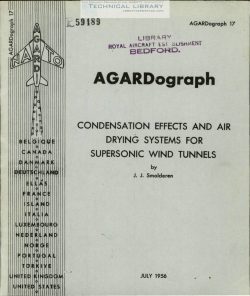AGARD-AG-17

- Version
- 229 Downloads
- 28.87 MB File Size
- 1 File Count
- September 20, 2016 Create Date
- September 20, 2016 Last Updated
Condensation Effects and Air Drying Systems for Supersonic Wind Tunnels

Various aspects of the condensation prob-
lem for supersonic wind tunnels are reviewed.
Part one is devoted to a study of the phe-
nomenon of condensation effects, the resulting
flow disturbances, and an investigation of the
possibility of complete removal of condensa-
tion effects. A criterion is presented, based
on certain experimental results. COnditions
under which flow disturbances are suffi-
ciently small are also indicated.
The second part is a study of various
drying processes in use and the third part
contains a survey of the different measuring
devices for the determination of humidity.
Condensation shocks were first described
by Prandtl (Ref. 1), who observed them in
a high-speed tunnel at Aachen, Germany.
Because a similar phenomenon had been
observed in steam nozzles, extensive ex-
perimental material is available on this
subject (see Refs. 2, 3, 4, 5, and 6).
A complete set of equations describing
the quasi-unidimensional flow of humid air
or saturated steam in a de Laval nozzle,
together with some experimental corrobora-
tion, has been published by Oswatitsch(Refs.
7, 8, 9, 10, and 11).
Since the partial pressure of a vapor
expanded through a nozzle decreases with
the temperature according to the adiabatic
law, while the saturation vapor pressure
decreases exponentially with the temper-
ature, it is possible to associate with each
value of initial humidity a certain amount
of expansion at which saturation will be
reached. Expansion beyond this point will
result in either condensation or supersatura-
tion of the air-water vapor mixture.
As a result of the rapid expansions and
short transit times involved in high-speed
nozzle flow, large amounts of supersaturation
may be expected to occur without condensa-
tion. However, beyond a certain degree of
supersaturation, which depends on the initial
conditions of the air, a strong condensation,
often called a condensation shock will occur.
For condensation to occur, a large number
of nuclei must be available. These nuclei
must be large enough so that the equilibrium
pressure associated with the nuclei is smaller
than the existing vapor pressure. The
greater the degree of supersaturation of
the air the smaller the dimensions of the
nuclei required to produce condensation.
Furthermore, for a small increase in the'
degree of supersaturation, the number of
nuclei which are effective in producing con-
densation may increase enormously so that
the condensation may occur abruptly like a
compression shock.
| File | Action |
|---|---|
| AGARD-AG-17 Condensation Effects and Air Drying Systems for Supersonic Wind Tunnels.pdf | Download |

Comment On This Post